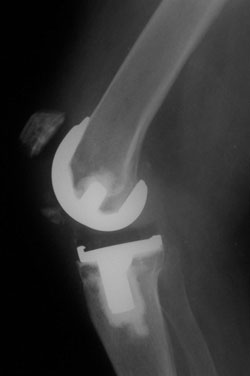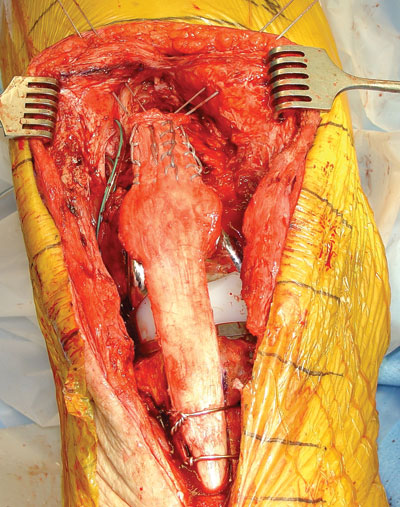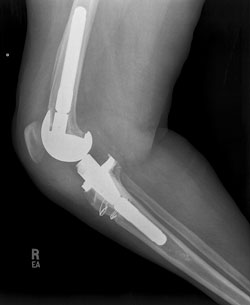Maximizing graft tension key in extensor mechanism allograft reconstruction
 Jess H. Lonner |
Extensor mechanism disruption, either from tendon rupture or patellar fracture, is uncommon — typically occurring in less than 2% of patients after total knee arthroplasty. However, the implications of an extensor mechanism disruption are at the top of the pyramid in terms of the potential ill consequences and resulting functional deficits.
Extensor mechanism compromise can result from traumatic, ischemic and technical causes. Many times these problems can be avoided or minimized with careful surgical technique. Protecting the extensor mechanism, particularly in tight knees, is paramount. To reduce the risk of patellar tendon rupture and avulsion, the key is to identify the tendon at risk and protect it at all costs during the surgical procedure. For instance, in stiff and scarred knees, the tendon can be protected with a pin in the tubercle insertion and with ancillary releases proximally or a tibial tubercle osteotomy distally.
Manipulation under anesthesia for knees that fail to gain motion should be performed within 3 months after total knee arthroplasty (TKA) to reduce the risk of periprosthetic fracture or extensor mechanism disruption that could be more likely to occur after that time frame.
Classic presentation
The presentation of complete extensor mechanism disruption is fairly consistent. There is pain and swelling, difficulty or inability to perform a straight leg raise without an extensor lag, and occasionally a palpable defect in the soft tissues overlying the disrupted tendon.
|
Images: Lonner JH |
Radiographically, complete patellar tendon ruptures are relatively straightforward to identify by patella alta. A quadriceps tendon rupture often has a more subtle presentation — slight patella baja may be present, but typically the more common finding is mild outward tilting of the proximal patella because of loss of the checkrein provided by the quadriceps muscles.
Reconstructive options
Primary patellar tendon repair without augmentation has been shown to be ineffective, leading to persistent rupture and poor results. There are a variety of extensor mechanism reconstruction techniques, including semitendinosis autograft and a variety of allografts. My preference is extensor mechanism allograft.
The reconstructive options depend on the quality of patellar bone and the integrity of the implant. Be prepared to revise the TKA. Leaving a mal-aligned, unstable or stiff TKA in place at the time of extensor mechanism allograft reconstruction, particularly in the setting of a flexion contracture, will put undue stress on the extensor mechanism reconstruction, compromise its strength and tension characteristics and predispose it to failure.
When performing an extensor mechanism allograft reconstruction, I use a fresh-frozen non-irradiated allograft with the maximal length of the quadriceps tendon preserved so that the proximal repair and quality of tensioning are optimized.
Patellar positioning
When preparing a trough in the patient’s tibia to accommodate the tibial tubercle component of the allograft, the key is to position the inferior pole of the patella allograft approximately 1 cm proximal to the joint line. From there, you can determine where in the patient’s tibia to make the trough.
The tibial tubercle allograft bone is prepared, fashioning a beveled dovetail proximally. Be careful not to remove too much bone from the allograft tubercle or you will be left with a fragment of tubercle allograft that is flimsy.
Then create a reverse dovetail pattern in the trough in the native proximal tibia to key in the allograft, trying to achieve a snug fit. Once again, remove the bone in a slow, piecemeal fashion because if too much bone is removed, fixation will be compromised. Gently impact the allograft bone into the prepared trough.
|
|
Fixation and tensioning
You can use cerclage wires or screws and washers for fixation, depending on your preference and whether there are stems and/or cement in the canal which may make screw passage difficult. If you use wires, tension them tightly. Position the knots off to the side and bury them under the soft tissues so that they are less likely to be prominent and irritating to the patient.
You then tension the graft, pulling the graft as far proximal in extension as you possibly can. Suture the allograft quadriceps tendon with a Krackow stitch using a #5 nonabsorbable suture, making sure to maximally tension the allograft with proximal pull of the allograft while advancing the native extensor mechanism and capsule distally in full extension, before suturing the graft to the surrounding soft tissues.
Securing the graft
Always try to overtension the extensor mechanism allograft as much as possible to avoid early failure resulting from stretching or tissue relaxation. After securing the graft, avoid the impulse to check passive flexion on the table because that may predispose it to stretching out before its time. The surgical site should be closed in extension.
I tend to keep my extensor mechanism reconstructions braced in extension for 3 months. Some surgeons will keep them braced or casted in extension for 6 weeks and then begin therapy, but my preference is to make these knees as stiff as possible. I have yet to have one of these patients complain of stiffness, but they will complain of weakness if they have an extensor lag.
|
|
I allow patients to begin isometric exercises immediately, while in the cast or brace. At 3 months postoperatively, I will allow knee flexion to 90· as tolerated and active knee extension against gravity. At 6 months, I will allow patients to start doing isometrics using ankle weights.
Functional limitations
The results can be satisfactory; however, even in combined series reviewing the experiences of skilled surgeons using sound techniques, 66% of patients do well. Still, one-third of patients will have an extensor lag of approximately 20°; and while 89% to 90% of patients can walk without ambulatory aids, there are still some functional limitations in these patients.
The importance of technique cannot be overstated. When you look at the published Rush experience, in their initial series they found that 100% of these knees failed with an extensor mechanism allograft due to undertensioning. However, with improved techniques and with overtensioning of the graft, they then achieved 100% success.
In conclusion, extensor mechanism disruption can be devastating. Extensor mechanism allograft reconstruction may yield reasonable results, although one-third of patients may still experience some functional limitations with weakness and the need for ambulatory aids.
References:
- Burnett RS, Berger RA, Paprosky WG, et al. Extensor mechanism allograft reconstruction after total knee arthroplasty. A comparison of two techniques. J Bone Joint Surg (Am.)2004;86(12):2694-2699.
- Emerson RH Jr, Head WC, Malinin TI. Extensor mechanism reconstruction with an allograft after total knee arthroplasty. Clin Orthop Relat Res.1994;(304):79-85.
- Leopold SS, Greidanus N, Paprosky WG, et al. High rate of failure of allograft reconstruction of the extensor mechanism after total knee arthroplasty. J Bone Joint Surg (Am.)1999;81(11):1574-1579.
- Lonner JH. Extensor mechanism disruption: when the unthinkable happens. Paper 95. Presented at the 26th Annual Current Concepts in Joint Replacement Winter Meeting. Dec. 9-12, 2009. Orlando, Fla.
- Nazarian DG, Booth RE, Jr. Extensor mechanism allografts in total knee arthroplasty. Clin Orthop Relat Res.1999;(367):123-129.
- Jess H. Lonner, MD, is director of knee replacement surgery at Pennsylvania Hospital. He can be reached at 800 Spruce St., Philadelphia, PA 19107-6130; 215-829-2461; e-mail: lonnerj@pahosp.com.









